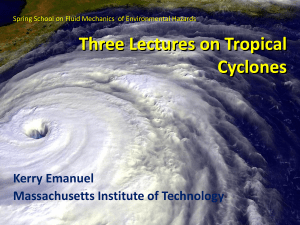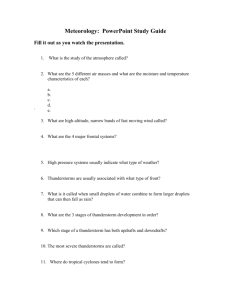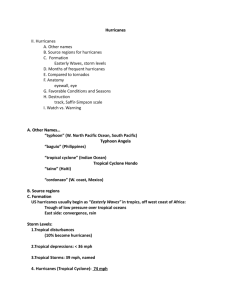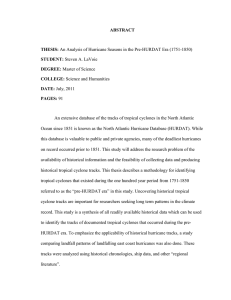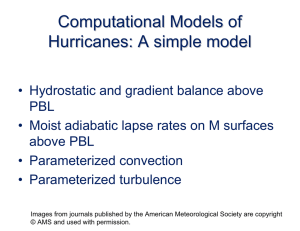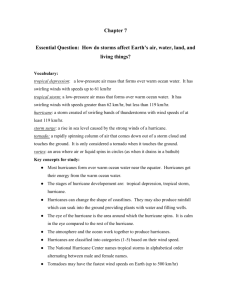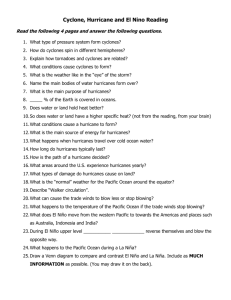PPT presentation file
advertisement
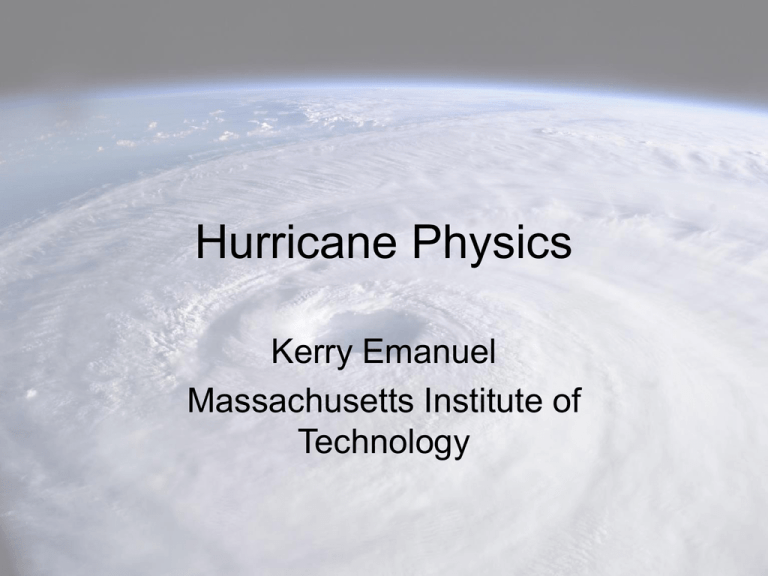
Hurricane Physics Kerry Emanuel Massachusetts Institute of Technology Program • • • • Overview of hurricanes Physics of mature, steady hurricanes The genesis problem Hurricanes and the thermohaline circulation 1. Overview: What is a Hurricane? Formal definition: A tropical cyclone with 1-min average winds at 10 m altitude in excess of 32 m/s (64 knots or 74 MPH) occurring over the North Atlantic or eastern North Pacific A tropical cyclone is a nearly symmetric, warm-core cyclone powered by windinduced enthalpy fluxes from the sea surface Tracks of all tropical cyclones, 1985-2005 Source: Wikipedia Hurricane Structure The View from Space Hurricane Structure: Wind Speed Azimuthal component of wind < 11 5 ms-1 - > 60 ms-1 Vertical Air Motion Updraft Speed Strong upward motion in the eyewall Physics of Mature Hurricanes Energy Production Carnot Theorem: Maximum efficiency results from a particular energy cycle: • • • • Isothermal expansion Adiabatic expansion Isothermal compression Adiabatic compression Note: Last leg is not adiabatic in hurricane: Air cools radiatively. But since environmental temperature profile is moist adiabatic, the amount of radiative cooling is the same as if air were saturated and descending moist adiabatically. Maximum rate of working: Ts To W Q Ts Total rate of heat input to hurricane: Q 2 r0 0 * 3 Ck | V | k0 k CD | V | rdr Surface enthalpy flux Dissipative heating In steady state, Work is used to balance frictional dissipation: W 2 r0 0 3 CD | V | rdr Plug into Carnot equation: r0 0 Ts To CD | V | rdr To 3 r0 0 Ck | V | k0* k rdr If integrals dominated by values of integrands near radius of maximum winds, C T T | Vmax |2 k s o k0* k CD To Theoretical Upper Bound on Hurricane Maximum Wind Speed: Surface temperature C T T * 2 k s o |V pot | k k T 0 C o D Ratio of exchange coefficients of enthalpy and momentum Outflow Air-sea enthalpy temperature disequilibrium Numerical simulations Thermodynamic disequilibrium necessary to maintain ocean heat balance: Ocean mixed layer Energy Balance (neglecting lateral heat transport): Ck | Vs | k k F F Fentrain * 0 V Greenhouse effect 2 pot Weak explicit dependence on Ts Ocean mixed layer entrainment Ts To F F Fentrain To CD | Vs | Mean surface wind speed Relationship between potential intensity (PI) and intensity of real tropical cyclones Why do real storms seldom reach their thermodynamic potential? One Reason: Ocean Interaction Ocean Interaction Mixed layer depth and currents SST Change Comparing Fixed to Interactive SST: A good simulation of Camille can only be obtained by assuming that it traveled right up the axis of the Loop Current: 2. Sea Spray 3. Wind Shear Dependence on Sea Surface Temperature (SST): What controls global tropical cyclone frequency? • In today’s climate, tropical cyclones must be triggered by independent disturbances • Tropical cyclone models also require finite amplitude perturbations to initiate hurricanes Numerical Simulations Axisymmetric, nonhydrostatic, cloudresolving model of Rotunno and Emanuel (J. Atmos. Sci., 1987); see Emanuel and Rotunno, Tellus, 1989. 3.75 km horizontal resolution; 300 m in vertical Classical initialization with warm-core vortex Same behavior in poor man’s model: Saturate troposphere inside 100 km in initial state: SST = 30 oC Integrations of a 3-D cloud system-resolving model in radiativeconvective equilibrium with fixed SST, by David Nolan SST = 35 oC Second Approach to Frequency Issue: Develop an empirical index based on monthly re-analysis data Test index against geographic, seasonal and interannual variability Empirical Index: I 105 V 3 3 2 H pot 50 70 3 2 10.1V shear 850 hPa absolute vorticity (s1), V pot Potential wind speed (ms1), H 600 mb relative humidity (%), V V V (ms1). shear 850 250 , Seasonal Variability: Northern Hemisphere Southern Hemisphere 500 300 Actual Predicted Actual Predicted 250 Number of Events Number of Events 400 300 200 100 0 200 150 100 50 2 4 6 Month 8 10 12 0 2 4 6 Month 8 10 12 Spatial Variability: Ocean Feedback Ocean Thermohaline Circulation Heat Transport by Oceans and Atmosphere A hot plate is brought in contact with the left half of the surface of a swimming pool of cold water. Heat diffuses downward and the warm water begins to rise. The strength of the circulation is controlled in part by the rate of heat diffusion. In the real world, this rate is very, very small. Adding a stirring rod to this picture greatly enhances the circulation by mixing the warm water to greater depth and bringing more cold water in contact with the plate. The strength of the lateral heat flux is proportional to the 2/3 power of the power put into the stirring, and the 2/3 power of the temperature of the plate. Coupled Ocean-Atmosphere model run for 67 of the 83 tropical cyclones that occurred in calendar year 1996 Accumulated TC-induced ocean heating divided by 366 days Result: Net column-integrated heating of ocean induced by global tropical cyclone activity: 15 W 1.4 0.7 10 Transient experiment by Rob Korty Summary • Hurricanes are almost perfect Carnot heat engines, operating off the thermodynamic disequilibrium between the tropical ocean and atmosphere, made possible by the greenhouse effect • Most hurricanes are prevented from reaching their potential intensity by storminduced ocean cooling and environmental wind shear • Hurricanes result from a finite-amplitude instability of the tropical oceanatmosphere system • Hurricane-induced mixing of the upper ocean may be the main driver of the ocean’s deep overturning circulation, an important component of the climate system
